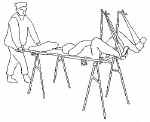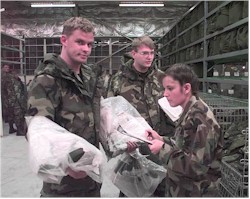|
Pre-deployment Planning
Planning for the medical support of women in operational environments
is important for a successful operation. Four planning areas are
particularly important:
-
Supplementation of AMALs (standard equipment and supplies) and
Sick Call Blocks to support female personnel
-
Establish Command policy on deployment and medical evacuation of
pregnant personnel
-
Pre-deployment screening of deploying women
-
Pre-deployment briefing of all personnel on women's health
issues and host nation customs

Medical Support of Women in Military Settings
MS PowerPoint
18 Slides
2.2 MB ppt file
Free
Download Now |
|
 AMAL and Sick Call Block
Supplementation
Knowing your available equipment and supplies is the first step.
Perform a line-item review of AMAL contents by category to insure your
familiarity with it. Frequently needed additional items include:
-
Small size surgical gloves worn by female medical personnel and
small males.
-
Equipment required for pelvic exams. The need to provide for
pelvic exams depends on your proximity to higher echelon operational
and fixed MTF's (Medical Treatment Facilities). If a better equipped
US Military facility nearby is able to provide this service, you may
not need to establish this capability. Maintaining pelvic exam
capability requires considerable logistical planning and funding. Do
not assume that every higher echelon facility has this capability -
check before you deploy.
-
Speculums - small and medium. Disposable types are good because
the ability to clean and repackage speculums in the field is
limited. However, metal instruments may be the only type available
and have the advantage of being reusable.
-
Light source - You will need some type of light source that can
be directed as needed. Goose neck or fiberoptic lights are nice but
not always available. Automotive type caged "shop lights" provide
excellent operational lighting, can be hung anywhere, and are
inexpensive.
-
Drapes - Some type of draping for exams should be provided,
disposable or fabric. Disposable drapes are rarely available. Bed
linens (sheets and blankets) are not included in AMALs. You'll need
to obtain these from unit supply. Note: you'll need some means to
wash non-disposable linens.
-
Microscope - ideally needed to perform wet-preps of vaginal
discharge, but this is optional as general clinical guidelines can
be used for brief field operations.
Consumable supplies - normal saline, KOH, microscope
slides, coverslips, lens paper, large and small cotton tip
applicators, K-Y Jelly, and stool guiaic kit.
Equipment for early OB care. This capability should be
taken into an operational setting only when large numbers (100+) of
deployed women are to be supported in a highly isolated setting or
when civilian humanitarian operations require.
-
An OB "Wheel" is very helpful.
-
Tape measure. It is helpful for measuring fundal
heights and for assessing any structure that might be enlarging over
time, such as masses, cysts, hematomas, etc.
-
Fetal Doppler. There is no good substitute for a
fetal Doppler. The DeLee stethoscopes are effective after 20 weeks
of pregnancy, but require some practice to be proficient. A Doppler
is much easier. Remember to bring ultrasonic conductive gel. If you
don't have any, any water-soluble lubricant such as K-Y jelly, will
serve reasonably well as a sonic conductor. Even water is better
than nothing.
Bedpan. This not only serves the obvious function but
provides excellent buttocks elevation for pelvic exams and precipitous
deliveries.
For routine obstetrical care, it is useful to have
some forms, including a prenatal risk assessment form and a standard
pregnancy form. Bring a precipitous delivery package...just in case!
-
Prenatal vitamins.
-
Iron tablets.
Continue
to the PowerPoint Lecture...
From:
Operational Obstetrics & Gynecology
2nd Edition
NAVMEDPUB 6300-2C
Bureau of Medicine and Surgery
Department of the Navy |


